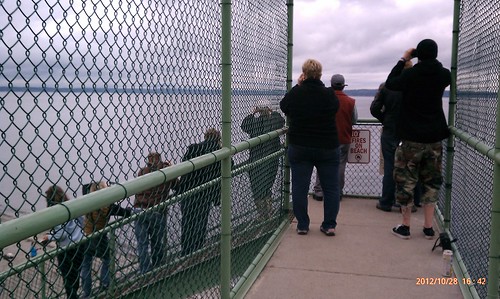Salmon Sighting in Carkeek Park
Nov. 6th, 2012 09:00 amJulie and I took a late afternoon trip to North Beach and Carkeek Parks Monday to look for salmon. Well, we stopped at North Beach Park on the way, so I could see how things are going.
The alders were still blocking the trail. But we did see some gorgeous fall color.
In fact, I thought the park was particularly beautiful. The cloud cover wasn’t too thick, and the colors were very warm. Where the path wasn’t covered in maple leaves, it was covered in alder leaves.
The park was also very wet. It’s gone from the driest I’ve ever seen it (in September) where just walking along a trail would cause it to crumble; to the wettest I’ve ever seen it, where you’re in constant danger of slipping, and leaves might cover mud a couple inches thick.
We also saw a pileated woodpecker, working its way up a snag. (It’s kind of small, click on the image for a slightly bigger version.) I saw a pileated woodpecker in 2010, I think, or maybe 2009. It was good to see one again.
It worked its way up the snag, its feet spread very wide to hold onto the snag. It pecked here and there, but didn’t have to knock the wood for quite a while. There were two flickers above it, working the same snag, but as it approached, they each flew away without saying anything.
After that, it was back up the trail and over to Piper’s Creek.
We started at the beach, as always. So far, there are only a couple dozen wigeons there regularly. But we also saw a cormorant off in the waters. (Later in the winter, there will be many more types of birds.) Besides the usual crows’n'gulls, I mean, who were enjoying the salmon buffet (that is, the fish that didn’t make it). Looking through the binoculars I saw about five different gulls eating at different salmon. Here is a picture of one that was picked clean.
Then it was back and over the bridge and up to Piper’s Creek. There were lots of salmon in the creek this time, resting in the pools, splashing upstream or over the rocks and logs.

Salmon splashing in Piper’s Creek, Carkeek Park. The curved line in the upper right quadrant is the back of the salmon.
I think we were up and down the various viewpoints of the creek for about an hour, talking to people and listening to their own observations. There are always a few families with young kids.
I’m sure we’ll go again. It’s always interesting to see them swimming around, and it’s exciting when one tries to make it over a little waterfall. No bears, and none of the giant waterfalls of rivers in Alaska. But raccoons, who will spread the fish carcasses around the woods.
Mirrored from Nature Intrudes. Please comment over there.


